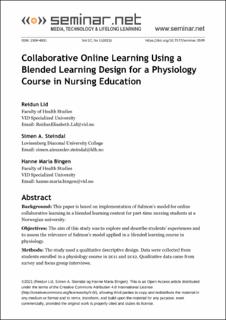| dc.contributor.author | Lid, Reidun | |
| dc.contributor.author | Steindal, Simen Alexander | |
| dc.contributor.author | Bingen, Hanne Maria S | |
| dc.date.accessioned | 2024-04-16T08:50:44Z | |
| dc.date.available | 2024-04-16T08:50:44Z | |
| dc.date.created | 2020-10-28T07:47:33Z | |
| dc.date.issued | 2021 | |
| dc.identifier.citation | Lid, R., Steindal, S. A., & Bingen, H. M. . (2021). Collaborative Online Learning Using a Blended Learning Design for a Physiology Course in Nursing Education. Seminar.net, 17(1). | en_US |
| dc.identifier.issn | 1504-4831 | |
| dc.identifier.uri | https://hdl.handle.net/11250/3126723 | |
| dc.description.abstract | Background: This paper is based on implementation of Salmon’s model for online collaborative learning in a blended learning context for part-time nursing students at a Norwegian university.
Objectives: The aim of this study was to explore and describe students’ experiences and to assess the relevance of Salmon’s model applied in a blended learning course in physiology.
Methods: The study used a qualitative descriptive design. Data were collected from students enrolled in a physiology course in 2011 and 2012. Qualitative data came from survey and focus group interviews.
Findings: Three themes emerged from this study: participation in both steps of the two-step design is important but challenging; online socialisation and a sense of group community support student participation and learning in group e-tivities; and the students’ perception of responsibility when collaborating online.
Conclusions: The teacher’s facilitation of online socialisation, participation, collaboration, feedback and intervention promoted a sense of community and was crucial for the students’ learning of physiology. However, a lack of confidence concerning professional physiology knowledge led to a greater dependency on the teacher than Salmon’s model suggests. The model may have limited potential in physiology, which requires causal reasoning. We suggest combining Salmon’s asynchronous model with synchronous activities. | en_US |
| dc.language.iso | eng | en_US |
| dc.publisher | Høgskolen i Innlandet | en_US |
| dc.rights | Navngivelse 4.0 Internasjonal | * |
| dc.rights.uri | http://creativecommons.org/licenses/by/4.0/deed.no | * |
| dc.subject | physiology | en_US |
| dc.subject | bioscience | en_US |
| dc.subject | Salmon’s model | en_US |
| dc.subject | nursing | en_US |
| dc.subject | teacher’s role | en_US |
| dc.subject | student’s role | en_US |
| dc.title | Collaborative online learning using a blended learning design for a physiology course in nursing education | en_US |
| dc.type | Peer reviewed | en_US |
| dc.type | Journal article | en_US |
| dc.description.version | publishedVersion | en_US |
| dc.rights.holder | ©2021(Reidun Lid, Simen A. Steindal og Hanne Maria Bingen). | en_US |
| dc.source.pagenumber | 1-27 | en_US |
| dc.source.volume | 17 | en_US |
| dc.source.journal | Seminar.net - Media, technology and lifelong learning | en_US |
| dc.source.issue | 1 | en_US |
| dc.identifier.doi | 10.7577/seminar.3599 | |
| dc.identifier.cristin | 1842763 | |
| cristin.ispublished | true | |
| cristin.fulltext | original | |
| cristin.qualitycode | 1 | |

